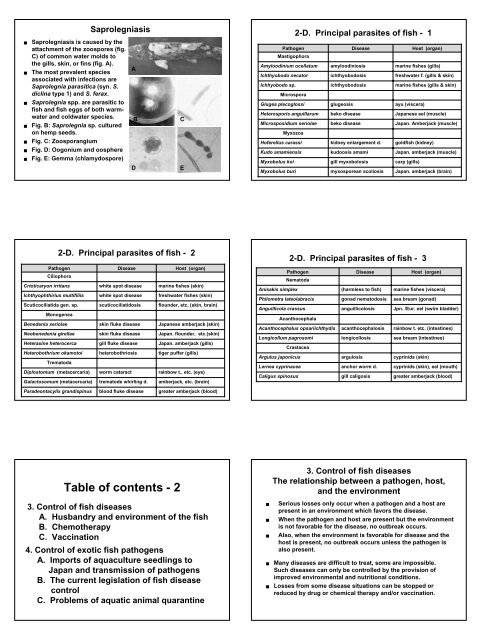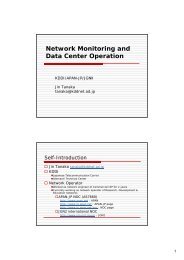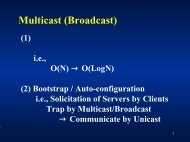DISEASE PROBLEMS IN FISH FARMING - SOI-Asia
DISEASE PROBLEMS IN FISH FARMING - SOI-Asia
DISEASE PROBLEMS IN FISH FARMING - SOI-Asia
Create successful ePaper yourself
Turn your PDF publications into a flip-book with our unique Google optimized e-Paper software.
Saprolegniasis<br />
Saprolegniasis is caused by the<br />
attachment of the zoospores (fig.<br />
C) of common water molds to<br />
the gills, skin, or fins (fig. A).<br />
The most prevalent species<br />
associated with infections are<br />
Saprolegnia parasitica (syn. S.<br />
diclina type 1) and S. ferax.<br />
Saprolegnia spp. are parasitic to<br />
fish and fish eggs of both warmwater<br />
and coldwater species.<br />
Fig. B: Saprolegnia sp. cultured<br />
on hemp seeds.<br />
Fig. C: Zoosporangium<br />
Fig. D: Oogonium and oosphere<br />
Fig. E: Gemma (chlamydospore)<br />
A<br />
B<br />
D<br />
C<br />
E<br />
2-D. Principal parasites of fish - 1<br />
Pathogen<br />
Disease<br />
Host (organ)<br />
Mastigophora<br />
Amyloodinium ocellatum amyloodiniosis<br />
marine fishes (gills)<br />
Ichthyobodo necator ichthyobodosis<br />
freshwater f. (gills & skin)<br />
Ichhyobodo sp.<br />
ichthyobodosis<br />
marine fishes (gills & skin)<br />
Microspora<br />
Glugea plecoglossi<br />
glugeosis<br />
ayu (viscera)<br />
Heterosporis anguillarum beko disease<br />
Japanese eel (muscle)<br />
Microsposidium seriolae beko disease<br />
Japan. Amberjack (muscle)<br />
Myxozoa<br />
Hoferellus carassi<br />
kidney enlargement d. goldfish (kidney)<br />
Kudo amamiensis<br />
kudoosis amami<br />
Japan. amberjack (muscle)<br />
Myxobolus koi<br />
gill myxobolosis<br />
carp (gills)<br />
Myxobolus buri<br />
myxosporean scoliosis Japan. amberjack (brain)<br />
2-D. Principal parasites of fish - 2<br />
Pathogen<br />
Disease<br />
Host (organ)<br />
Ciliophora<br />
Crtoticaryon irritans<br />
white spot disease marine fishes (skin)<br />
Ichthyophthirius multifiliis white spot disease freshwater fishes (skin)<br />
Scuticociliatida gen. sp. scuticociliatidosis flounder, etc. (skin, brain)<br />
Monogenea<br />
Benedenia seriolae<br />
skin fluke disease Japanese amberjack (skin)<br />
Neobenedenia girellae<br />
skin fluke disease Japan. flounder, etc.(skin)<br />
Heteraxine heterocerca gill fluke disease Japan. amberjack (gills)<br />
Heterobothrium okamotoi heterobothriosis tiger puffer (gills)<br />
Trematoda<br />
Diplostomum (metacercaria) worm cataract<br />
rainbow t., etc. (eye)<br />
Galactosomum (metacercaria) trematode whirling d. amberjack, etc. (brain)<br />
2-D. Principal parasites of fish - 3<br />
Pathogen<br />
Disease<br />
Host (organ)<br />
Nematoda<br />
Anisakis simplex<br />
(harmless to fish) marine fishes (viscera)<br />
Philometra lateolabracis<br />
gonad nematodosis sea bream (gonad)<br />
Anguillicola crassus<br />
anguillicolosis Jpn. /Eur. eel (swim bladder)<br />
Acanthocephala<br />
Acanthocephalus opsariichthydis acanthocephalosis rainbow t. etc. (intestines)<br />
Longicollum pagrosomi<br />
longicollosis sea bream (intestines)<br />
Crastacea<br />
Argulus japonicus<br />
argulosis<br />
cyprinids (skin)<br />
Lernea cyprinacea<br />
anchor worm d. cyprinids (skin), eel (mouth)<br />
Caligus spinosus<br />
gill caligosis greater amberjack (blood)<br />
Paradeontacylix grandispinus<br />
blood fluke disease<br />
greater amberjack (blood)<br />
Table of contents - 2<br />
3. Control of fish diseases<br />
A. Husbandry and environment of the fish<br />
B. Chemotherapy<br />
C. Vaccination<br />
4. Control of exotic fish pathogens<br />
A. Imports of aquaculture seedlings to<br />
Japan and transmission of pathogens<br />
B. The current legislation of fish disease<br />
control<br />
C. Problems of aquatic animal quarantine<br />
<br />
<br />
<br />
3. Control of fish diseases<br />
The relationship between a pathogen, host,<br />
and the environment<br />
Serious losses only occur when a pathogen and a host are<br />
present in an environment which favors the disease.<br />
When the pathogen and host are present but the environment<br />
is not favorable for the disease, no outbreak occurs.<br />
Also, when the environment is favorable for disease and the<br />
host is present, no outbreak occurs unless the pathogen is<br />
also present.<br />
Many diseases are difficult to treat, some are impossible.<br />
Such diseases can only be controlled by the provision of<br />
improved environmental and nutritional conditions.<br />
Losses from some disease situations can be stopped or<br />
reduced by drug or chemical therapy and/or vaccination.










